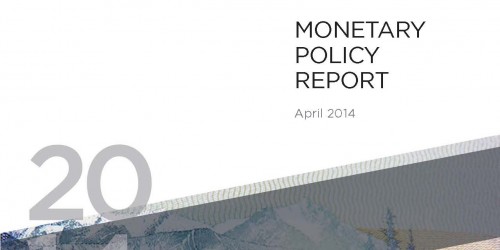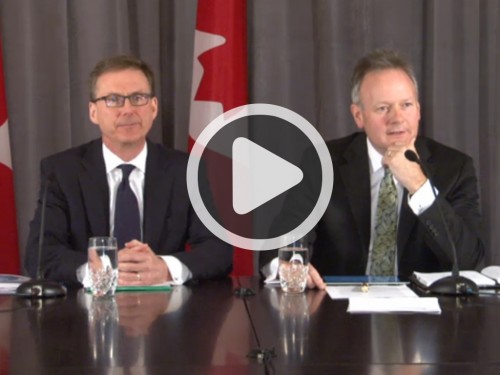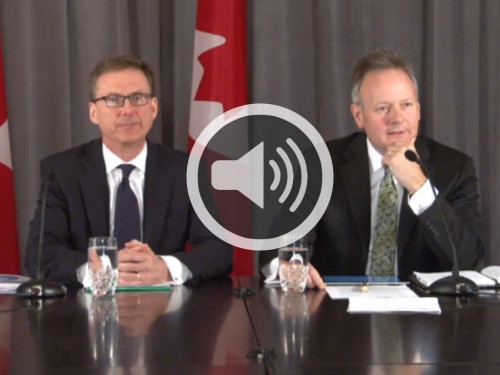Release of the Monetary Policy Report
Good morning. Tiff and I are pleased to join you today by videoconference.
As you know, we are in Toronto to attend the funeral this afternoon of Canada’s former Finance Minister, Jim Flaherty. Before we discuss the Monetary Policy Report, I’d like to say a few words about him. What set Jim Flaherty apart was that while he was a formidable Finance Minister, he was first and foremost an ordinary man. You immediately connected to him after just a few minutes, and it was immediately clear that he was there for Canada, 100 per cent. That's what he did all day, every day. And to everything that he did, he brought a solid dose of common sense. People found that attractive and helpful, and his gut instincts were usually right. A lot of his legacy is right there for us. I'll miss him tremendously, and Canada is the poorer without him.
Let me turn now to the MPR, which the Bank published this morning. Before we take your questions, allow me to note its highlights.
- Inflation in Canada remains low. Core inflation is expected to stay well below our 2 per cent target this year and it will take close to two years for it to return to the target. Total CPI inflation is expected to move closer to the target in the coming quarters due to temporary factors.
- Let me take a moment to explain this inflation forecast. Core inflation is expected to remain below target due to the effects of economic slack and heightened retail competition. We expect these effects to persist until early 2016.
- However, total CPI inflation will move up this year, before core, in response to higher consumer energy prices, as well as the lower Canadian dollar.
- We expect total CPI inflation will remain fairly close to target throughout the projection period. That’s because in 2015 and into early 2016, as the upward pressure from energy prices dissipates, the downward pressure from retail competition should gradually fade and excess capacity will be falling. This will cause core inflation to make its way gradually up to 2 per cent, catching up to total CPI inflation from below.
- The global economic expansion is expected to strengthen over the next three years as headwinds that have been restraining activity dissipate.
- The economic recovery in the United States appears to be on track, despite soft readings in the last few months largely due to unusual weather. Indeed, private demand could turn out to be stronger than anticipated.
- Europe’s economy is growing modestly, but inflation remains too low and the nascent recovery could be undermined by risks emanating from the Russia-Ukraine situation.
- In China and other emerging-market economies growth is expected to be solid, although there are growing concerns about financial vulnerabilities.
- Overall, global growth is expected to pick up to 3.3 per cent in 2014 and increase further to 3.7 per cent in 2015 and 2016 - largely unchanged from January.
- The Bank continues to expect Canada’s real GDP growth to average about 2 1/2 per cent in 2014 and 2015 before easing to around the 2 per cent growth rate of the economy’s potential in 2016.
- Competitiveness challenges continue to weigh on Canadian exporters’ ability to benefit from stronger growth abroad.
- As an open economy, the performance of Canada’s export sector is critical. Given the growing wedge between Canada’s exports and foreign demand, the Bank has deepened its analysis of this sector. Our research has broken down the export sector into a large number of subsectors and we are discovering that there is a range of subsectors for which exports have been in line with the fundamentals - or better.
- This suggests that as the U.S. recovery gathers momentum and becomes more broadly-based, many of our exports will benefit. The lower Canadian dollar should provide additional support and we can be more confident about our recovery in these subsectors.
- Other subsectors are experiencing greater competitiveness challenges and, for them, the wedge remains. The recovery for these groups will be slower, even as they are helped by the lower exchange rate for the Canadian dollar.
- This analysis provides a more granular interpretation of the export picture. Overall, we expect a gradual convergence between the growth rate of Canada’s exports and that of the U.S. economy. But this implies some of the wedge between exports and foreign demand will be very persistent.
- Further, we continue to believe that rising global demand for Canadian goods and services, combined with the assumed high level of oil prices, will stimulate business investment in Canada and shift the economy to a more sustainable growth track.
- Recent developments are in line with the Bank’s expectation of a soft landing in the housing market and stabilizing debt-to-income ratios for households. Still, household imbalances remain elevated and would pose a significant risk should economic conditions deteriorate.
- In sum, the Bank continues to see a gradual strengthening in the fundamental drivers of growth and inflation in Canada. This view hinges critically on the projected upturn in exports and investment. With underlying inflation expected to remain below target for some time, the downside risks to inflation remain important. At the same time, the risks associated with household imbalances remain elevated.
- The Bank judges that the balance of these risks remains within the zone for which the current stance of monetary policy is appropriate and therefore has decided to maintain the target for the overnight rate at 1 per cent. The timing and direction of the next change to the policy rate will depend on how new information influences the balance of risks.
With that, Tiff and I would be pleased to take your questions.


